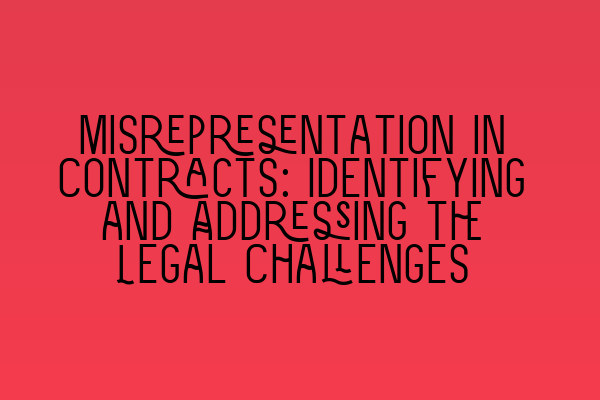Title: Misrepresentation in Contracts: Identifying and Addressing the Legal Challenges
Introduction:
Welcome to SQE Contract Law’s blog post on misrepresentation in contracts. In today’s complex and rapidly changing business environment, understanding the legal challenges surrounding misrepresentation is crucial. Whether you are a business owner, a contract law professional, or someone simply interested in learning more about this topic, this post aims to provide you with valuable insights and guidance. So, let’s delve into the world of misrepresentation and explore how to effectively identify and address the legal challenges associated with it.
What is Misrepresentation?
Misrepresentation occurs when one party to a contract makes a false statement of fact with the intention of inducing the other party to enter into the contract. Such false statements can be made orally, in writing, or even through conduct.
Types of Misrepresentation:
To gain a comprehensive understanding, it is important to familiarize ourselves with the different types of misrepresentation:
1. Innocent Misrepresentation:
Innocent misrepresentation occurs when a false statement is made without any knowledge that it is untrue. Although the party making the false statement may not have any intention to deceive, the innocent party may still have the right to rescind the contract.
2. Negligent Misrepresentation:
Negligent misrepresentation arises when a party makes a false statement without reasonable grounds for believing it to be true or without exercising a reasonable degree of care in obtaining the information on which the statement is based. If the innocent party suffers damages as a result, they may be entitled to remedies, including rescission and/or damages.
3. Fraudulent Misrepresentation:
Fraudulent misrepresentation is characterized by the willful and deliberate act of making a false statement with the intention to deceive the other party. Such misrepresentations not only entitle the innocent party to seek remedies but may also lead to potential statutory or criminal liabilities.
Identifying Misrepresentation:
Recognizing misrepresentation can be challenging, but there are some essential elements to consider. These include:
– The false statement: Determine if a false statement of fact has been made.
– Reliance: Assess whether the innocent party relied on the false statement when entering into the contract.
– Materiality: Establish if the false statement was material, meaning it influenced the innocent party’s decision to enter into the contract.
– Causation: Prove a causal link between the misrepresentation and any losses suffered by the innocent party.
Addressing the Legal Challenges:
It is imperative to take appropriate steps when addressing misrepresentation in contracts. Here are some key points to consider:
1. Review and Draft Contracts Thoroughly:
Ensure contracts are drafted with precision, explicitly addressing misrepresentation and its consequences. Seek legal guidance to identify potential pitfalls and ambiguities within your contracts.
2. Conduct Due Diligence:
Before entering into a contract, conduct thorough due diligence on the other party. Verify the accuracy of any statements made, gather evidence, and consult experts if necessary.
3. Seek Legal Advice:
If you suspect misrepresentation in a contract, promptly seek legal advice from an experienced contract law professional. They can guide you on the most appropriate course of action based on the nature of the misrepresentation and applicable laws.
4. Negotiate Resolution:
Consider negotiating a resolution with the other party before resorting to litigation. Mediation or alternative dispute resolution methods can save time and costs while still achieving a fair outcome.
Conclusion:
Misrepresentation in contracts can have significant consequences for all parties involved. By understanding the types of misrepresentation, identifying its signs, and taking proactive legal steps, you can mitigate the risks and protect your interests. Remember, seeking the advice of a qualified solicitor is crucial to navigate the complex legal challenges effectively. Stay informed, stay proactive, and ensure your contracts are built on a foundation of honesty and transparency.
